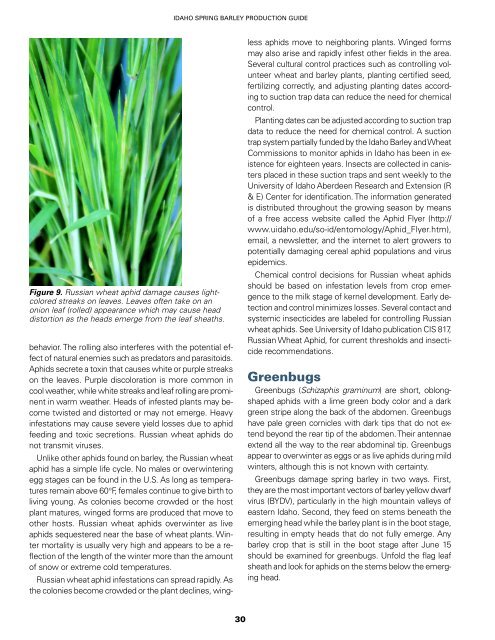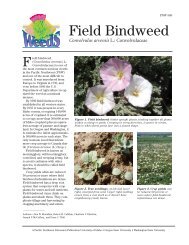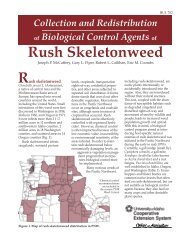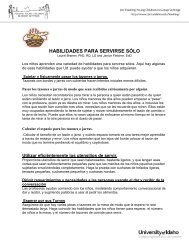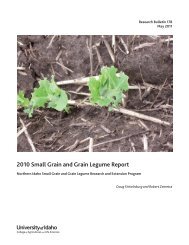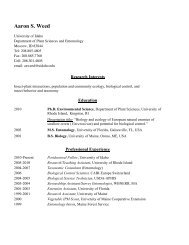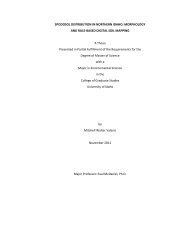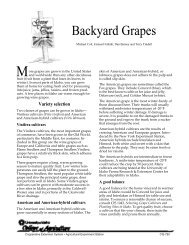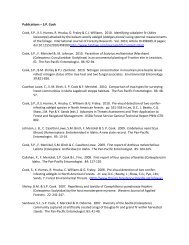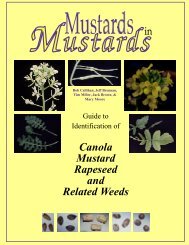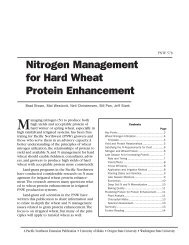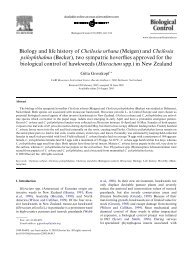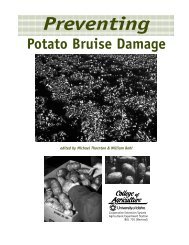Spring Barley Production Guide - College of Agricultural and Life ...
Spring Barley Production Guide - College of Agricultural and Life ...
Spring Barley Production Guide - College of Agricultural and Life ...
You also want an ePaper? Increase the reach of your titles
YUMPU automatically turns print PDFs into web optimized ePapers that Google loves.
Figure 9. Russian wheat aphid damage causes lightcolored<br />
streaks on leaves. Leaves <strong>of</strong>ten take on an<br />
onion leaf (rolled) appearance which may cause head<br />
distortion as the heads emerge from the leaf sheaths.<br />
behavior. The rolling also interferes with the potential effect<br />
<strong>of</strong> natural enemies such as predators <strong>and</strong> parasitoids.<br />
Aphids secrete a toxin that causes white or purple streaks<br />
on the leaves. Purple discoloration is more common in<br />
cool weather, while white streaks <strong>and</strong> leaf rolling are prominent<br />
in warm weather. Heads <strong>of</strong> infested plants may become<br />
twisted <strong>and</strong> distorted or may not emerge. Heavy<br />
infestations may cause severe yield losses due to aphid<br />
feeding <strong>and</strong> toxic secretions. Russian wheat aphids do<br />
not transmit viruses.<br />
Unlike other aphids found on barley, the Russian wheat<br />
aphid has a simple life cycle. No males or overwintering<br />
egg stages can be found in the U.S. As long as temperatures<br />
remain above 60°F, females continue to give birth to<br />
living young. As colonies become crowded or the host<br />
plant matures, winged forms are produced that move to<br />
other hosts. Russian wheat aphids overwinter as live<br />
aphids sequestered near the base <strong>of</strong> wheat plants. Winter<br />
mortality is usually very high <strong>and</strong> appears to be a reflection<br />
<strong>of</strong> the length <strong>of</strong> the winter more than the amount<br />
<strong>of</strong> snow or extreme cold temperatures.<br />
Russian wheat aphid infestations can spread rapidly. As<br />
the colonies become crowded or the plant declines, wing-<br />
IDAHO SPRING BARLEY PRODUCTION GUIDE<br />
30<br />
less aphids move to neighboring plants. Winged forms<br />
may also arise <strong>and</strong> rapidly infest other fields in the area.<br />
Several cultural control practices such as controlling volunteer<br />
wheat <strong>and</strong> barley plants, planting certified seed,<br />
fertilizing correctly, <strong>and</strong> adjusting planting dates according<br />
to suction trap data can reduce the need for chemical<br />
control.<br />
Planting dates can be adjusted according to suction trap<br />
data to reduce the need for chemical control. A suction<br />
trap system partially funded by the Idaho <strong>Barley</strong> <strong>and</strong> Wheat<br />
Commissions to monitor aphids in Idaho has been in existence<br />
for eighteen years. Insects are collected in canisters<br />
placed in these suction traps <strong>and</strong> sent weekly to the<br />
University <strong>of</strong> Idaho Aberdeen Research <strong>and</strong> Extension (R<br />
& E) Center for identification. The information generated<br />
is distributed throughout the growing season by means<br />
<strong>of</strong> a free access website called the Aphid Flyer (http://<br />
www.uidaho.edu/so-id/entomology/Aphid_Flyer.htm),<br />
email, a newsletter, <strong>and</strong> the internet to alert growers to<br />
potentially damaging cereal aphid populations <strong>and</strong> virus<br />
epidemics.<br />
Chemical control decisions for Russian wheat aphids<br />
should be based on infestation levels from crop emergence<br />
to the milk stage <strong>of</strong> kernel development. Early detection<br />
<strong>and</strong> control minimizes losses. Several contact <strong>and</strong><br />
systemic insecticides are labeled for controlling Russian<br />
wheat aphids. See University <strong>of</strong> Idaho publication CIS 817,<br />
Russian Wheat Aphid, for current thresholds <strong>and</strong> insecticide<br />
recommendations.<br />
Greenbugs<br />
Greenbugs (Schizaphis graminum) are short, oblongshaped<br />
aphids with a lime green body color <strong>and</strong> a dark<br />
green stripe along the back <strong>of</strong> the abdomen. Greenbugs<br />
have pale green cornicles with dark tips that do not extend<br />
beyond the rear tip <strong>of</strong> the abdomen. Their antennae<br />
extend all the way to the rear abdominal tip. Greenbugs<br />
appear to overwinter as eggs or as live aphids during mild<br />
winters, although this is not known with certainty.<br />
Greenbugs damage spring barley in two ways. First,<br />
they are the most important vectors <strong>of</strong> barley yellow dwarf<br />
virus (BYDV), particularly in the high mountain valleys <strong>of</strong><br />
eastern Idaho. Second, they feed on stems beneath the<br />
emerging head while the barley plant is in the boot stage,<br />
resulting in empty heads that do not fully emerge. Any<br />
barley crop that is still in the boot stage after June 15<br />
should be examined for greenbugs. Unfold the flag leaf<br />
sheath <strong>and</strong> look for aphids on the stems below the emerging<br />
head.


